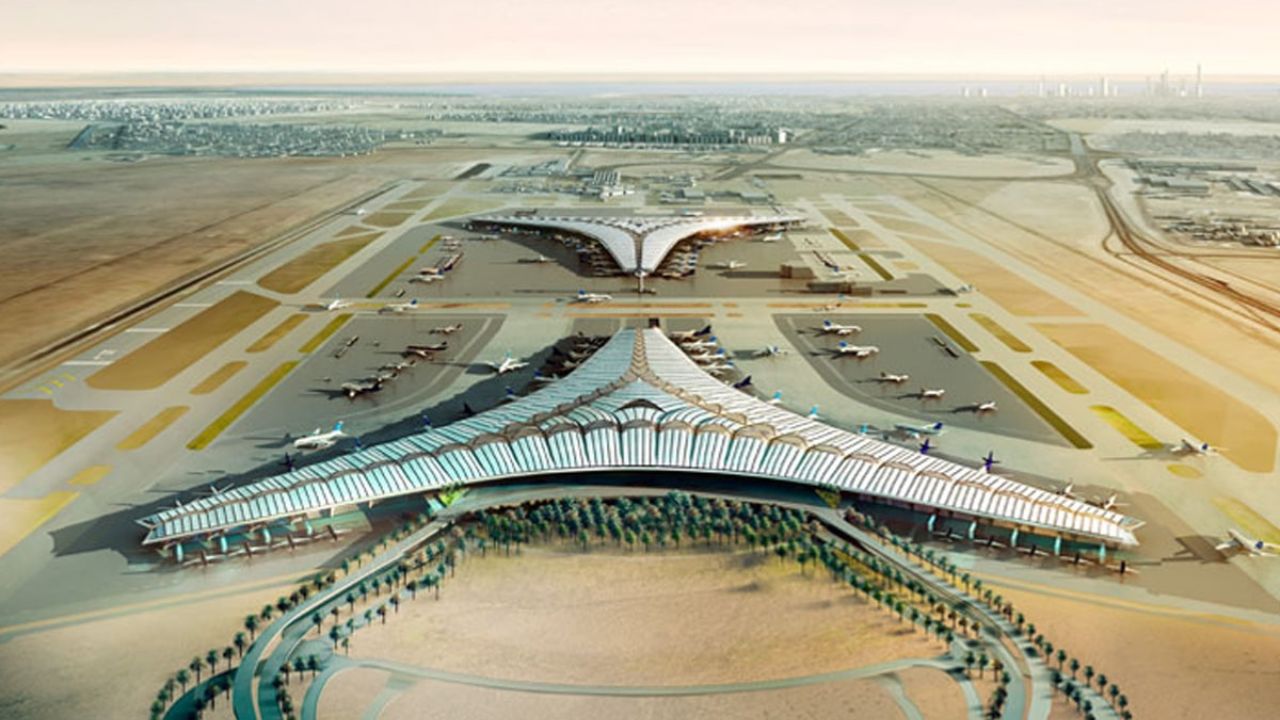GCC Airports in expansion Race as UAE, Saudi, Qatar, Kuwait, Oman Spend Billions of dollars on upgrades. Airports have become more than just transportation hubs; they are often the first touchpoint a traveler has with a country. A well-managed, state-of-the-art airport can provide a strong impression of a country’s ambitions, efficiency, and technological capabilities.
- GCC Airport Expansion Projects
- Al Maktoum International Airport – Dubai, UAE
- King Salman International Airport – Riyadh, Saudi Arabia
- Red Sea International Airport – Red Sea, Saudi Arabia
- Abha International Airport – Aseer Region, Saudi Arabia
- Hamad International Airport – Doha, Qatar
- Kuwait International Airport – Kuwait City, Kuwait
- Oman’s New Airport Strategy
- The Role of Airlines in GCC Airport Expansion
- GCC’s Aviation Dominance
- Conclusion
The GCC (Gulf Cooperation Council) nations, home to some of the world’s most prominent airlines, have recognized this strategic value and are now investing billions of dollars into expanding their airport infrastructures. In the coming years, we are set to witness a new era of competition among airports in the UAE, Saudi Arabia, Qatar, Kuwait, and Oman as they race to dominate global aviation.
The recent rankings in the 2024 World Airport Awards by SkyTrax, which crowned Doha’s Hamad International Airport as the best in the world, ahead of Singapore’s Changi Airport, have intensified this race. Dubai International also climbed to the seventh position, reinforcing the region’s growing influence on the global stage. These accolades are the result of long-term investments in not only enhancing the passenger experience but also expanding capacity to meet future demand.
Related Posts
The Vision for Middle Eastern Airports
Historically, Middle Eastern airports were regarded as technical stops by global airlines. However, this perception has transformed dramatically since the late 20th century. The shift began with Dubai’s vision in the 1980s to turn the city into a major aviation hub, spearheaded by the launch of Emirates Airline in 1985.
Since then, the entire region has embraced its strategic location, making it an essential crossroads for global air traffic, especially for long-haul flights connecting Asia, Europe, and North America.
Today, this vision is being taken even further, with countries like Saudi Arabia unveiling ambitious plans under Vision 2030. This national reform agenda aims to diversify the Kingdom’s economy, with tourism and aviation being key pillars. Saudi Arabia’s goal to handle 300 million air passengers by 2030, nearly tripling its current numbers, is just one example of the audacious targets set by GCC nations.
The UAE also has its own roadmap to elevate its tourism sector, aiming to attract AED100 billion ($27.23 billion) in investments and 40 million hotel guests by 2031. Central to both Saudi Arabia’s and the UAE’s plans are massive infrastructure projects that will significantly increase the capacity of their airports, enabling them to serve as major gateways for global travel.
GCC Airport Expansion Projects
To achieve these lofty goals, airports across the GCC are undergoing significant upgrades, expansions, and even complete overhauls. These investments are not just about increasing passenger numbers; they are designed to improve operational efficiency, cargo handling, and overall traveler experience. Let’s take a look at some of the most significant airport projects currently underway.
Al Maktoum International Airport – Dubai, UAE
Dubai’s Al Maktoum International Airport, part of the Dubai World Central (DWC) project, is set to become the world’s largest airport in terms of capacity. The Dubai government has committed AED128 billion ($34.85 billion) to this expansion. Once completed, the airport will be capable of handling an unprecedented 260 million passengers annually.
This vast infrastructure project includes the construction of 400 gates, five parallel runways, and a terminal complex that will eventually be five times the size of the existing Dubai International Airport (DXB).
The first phase of this project, which will add capacity for 150 million passengers per year, is expected to be completed within the next decade. The expansion will not only solidify Dubai’s position as a global aviation hub but also serve the emirate’s rapidly growing cargo business, with a planned capacity of 12 million tonnes of cargo annually.
King Salman International Airport – Riyadh, Saudi Arabia
Announced in 2022, King Salman International Airport in Riyadh is one of the most ambitious airport projects in the world. Covering 57 square kilometers, it will feature six parallel runways and a series of new terminals. The Kingdom aims for this airport to handle 120 million passengers by 2030, and an even more staggering 185 million passengers by 2050.
Designed by Foster + Partners, the airport will be a beacon of modern architecture, integrating Riyadh’s identity and Saudi culture to deliver a world-class experience. The airport will also handle 3.5 million tons of cargo annually, enhancing Saudi Arabia’s logistics capabilities.
Red Sea International Airport – Red Sea, Saudi Arabia
Designed with sustainability at its core, Red Sea International Airport will support the Saudi Red Sea Project, a major tourism initiative. Powered entirely by renewable energy, the airport is designed to resemble the natural surroundings, with five terminal “pods” inspired by the desert. By 2030, the airport will be able to handle one million passengers, serving tourists heading to the Red Sea’s luxury resorts and eco-tourism destinations.
Abha International Airport – Aseer Region, Saudi Arabia
The Abha International Airport expansion is another key element of Saudi Arabia’s aviation growth strategy. Upon completion in 2028, the airport will boost its capacity to 13 million passengers annually from the current 1.5 million. This $1.4 billion expansion project is part of the Kingdom’s efforts to accommodate rising tourism and business travel in the Aseer region.
Hamad International Airport – Doha, Qatar
Hamad International Airport is also undergoing a major expansion. Following the success of hosting the 2022 FIFA World Cup, the airport is now in its Phase B development, which will increase its annual capacity to 70 million passengers. This phase includes a new 95,000-square-meter concourse, cargo terminal expansions, and the construction of new luxury lounges and retail spaces, further cementing Qatar’s place on the world aviation map.
Kuwait International Airport – Kuwait City, Kuwait
Kuwait is investing heavily in the modernization of its airport, with a focus on Terminal 2, which will increase capacity to 25 million passengers annually by 2025. The new terminal, which incorporates climate-responsive design to cope with the region’s extreme heat, is part of a broader strategy to upgrade Kuwait’s aviation sector to meet the growing demand for both passenger and cargo services.
Oman’s New Airport Strategy
Oman is also making significant moves to expand its airport infrastructure. The Sultanate plans to build six new airports by 2029, adding to its existing network. The new airports will connect Oman’s growing tourism industry, particularly in Musandam and other key areas, with its major industrial centers in Sohar, Salalah, and Duqm. By 2040, Oman aims to welcome 50 million tourists annually, up from 17 million in 2023.
The Role of Airlines in GCC Airport Expansion
At the heart of these airport expansions are the region’s airlines, which are placing substantial aircraft orders to meet future demand. As of 2023, the 10 largest airlines in the Middle East have collectively ordered 795 new aircraft to be delivered by the end of the decade. These orders align with the airport expansions, ensuring that the region can accommodate rising passenger numbers while enhancing connectivity.
GCC’s Aviation Dominance
The massive airport infrastructure projects across the GCC underscore the region’s strategic ambition to dominate global aviation. With its favorable geographic location, connecting the East and West, the Middle East is poised to capture an even larger share of international travel and logistics. The continued investments in cutting-edge technologies, sustainability, and passenger experience are setting new global standards for airport operations.
Conclusion
The expansion of airports in the GCC is not just about increasing capacity; it is about creating a seamless, world-class travel experience that reflects the economic ambitions of the region. As Saudi Arabia, the UAE, Qatar, Kuwait, and Oman continue to push the boundaries of what airports can offer, they are positioning themselves at the forefront of the global aviation industry.










